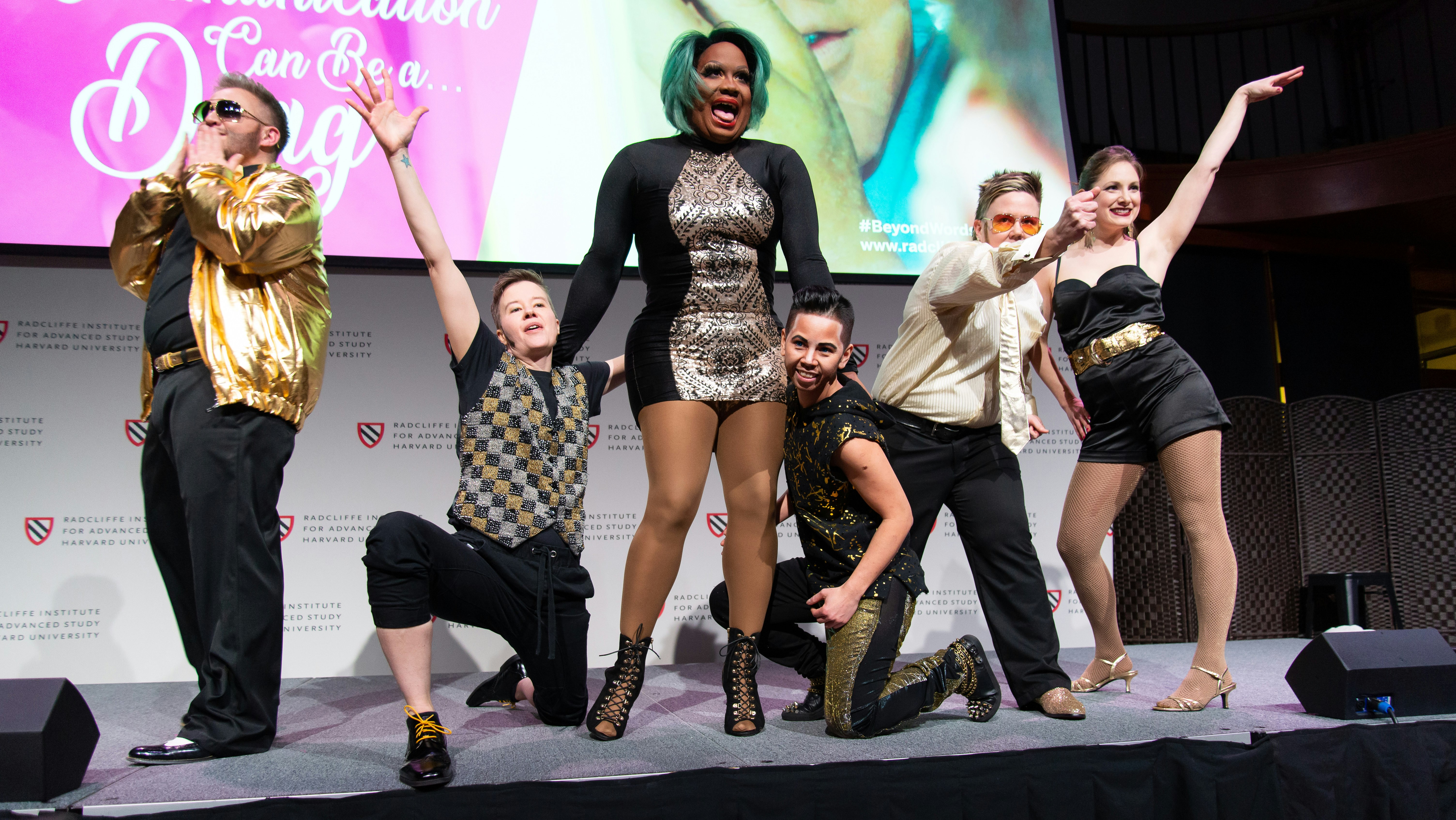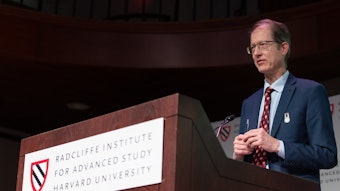Speaking Volumes, with One Caveat

Gender conference celebrates the power of nonverbal communication.
“I and this mystery here we stand.”
—Walt Whitman, “Song of Myself”
Invoking the poetic wisdom of Walt Whitman, John Durham Peters delivered the framing remarks at the full-day session of the Radcliffe Institute’s conference “Beyond Words: Gender and the Aesthetics of Communication.”
“I can’t think of a topic more pressing, more painful, more interesting, more beautiful, than gender,” said Peters, the Maria Rosa Menocal Professor of English and of Film and Media Studies at Yale University. “I can’t say what it is, and I can’t say what it means,” he added, but let us “celebrate the many forms we can take.”
The late-winter event brought together an eclectic group of speakers who through their unique perspectives explored the aesthetics of communication. The audience at the Knafel Center learned about the growing popularity of tattoos among women, the complex language of perfumes, the nonverbal world of animal behavior, and the personality differences embedded in smart speakers.
“There is so much more communicated than . . . what we explicitly express,” said the conference’s organizer, Shigehisa Kuriyama, faculty director of Radcliffe’s humanities program and the Reischauer Institute Professor of Cultural History in the Harvard Faculty of Arts and Sciences.
IN HER KEYNOTE, Valerie Steele, director and chief curator of Manhattan’s Museum at the Fashion Institute of Technology, described the long evolution of fashion and its part in communicating gender roles and cultural trends.
For centuries, one of the key gender differentiators in fashion was that women wore a skirt or a dress, and men wore some sort of bifurcated garment, such as leggings or trousers. “From 1860 to 1955, in Western culture you’ll find this rigid dimorphism in clothing,” she said.
Steele, who has organized more than 25 exhibitions and published extensively on fashion, traced the history of several enduring icons. The corset, which for centuries was worn by aristocrats, was eventually adopted by fashionable women of all classes. Losing its appeal by the beginning of the 20th century, it began to play more of a role in fetish culture.
The high-heel shoe is in some ways the modern-day equivalent of a corset, Steele said. “When you hear people anathematizing fashion, they seldom mention corsets anymore except as historical evidence of patriarchy torturing women, but they frequently mention high-heel shoes.”
Leather has been an important component of fashion. “One of the key things about both the corset and leather is the association with the hard body,” Steele said.
She also spoke to the ways fashion signals status and power: “It’s fairly rare that men have copied things from the female wardrobe. In general, the idea is to dress like someone who has more power.” The business suit appeals to women as a status symbol. People will also appropriate the fashions of others, Steele noted, if they are seen as more virile, authentic, or cool.
“A lot of people hate fashion,” said Steele in response to a question about the relationship between the body and clothing. “One of the main crimes of fashion is that it’s seen as being artificial, not natural. But the idea that the body itself is natural is of course a complete fantasy, because we structure our bodies in innumerable ways. We’re taught to stand and walk, we cut our hair, we shave, we do all kinds of things to our bodies. Rather than pitting body versus clothing, it’s more useful when you’re thinking of the relationship to think of the body/clothes unit as being what you’re using to convey aspects of identity.”
Steele took particular aim at the academic community for its attitude toward fashion. “Fashion is despised widely in American society, but it is especially despised within American academia,” she said. “The idea is that the life of the mind means that the life of the body is immaterial.”
She also addressed whether fashion is shifting from a look of overt sexuality to one of asexuality. “Some designers have tried to deemphasize overt sexual characteristics in clothing, but others have in fact stretched the idea of taking something which might be stereotypically sexy in one area and seeing what happens if you have other people wear it,” she said. “Very often, to make it popular you don’t rebrand it as asexual, you brand it as being both sexual and a range of sexual, because, really, how many people want to be sexually neutral?”
A TRIO OF DANCERS—Ayodele Casel RI ’20, Antoine Hunter, and Jill Johnson—brought the afternoon to a close as they spoke about dance’s power to communicate as a nonverbal art form. For Hunter, who was born mostly deaf, dance was a path out of isolation. Asked in a high school dance class to choreograph and dance a solo piece, he discovered a way to connect with others. “I communicated and had that connection,” said Hunter, who is the founder and artistic director of the Urban Jazz Dance Company and Bay Area International Deaf Dance Festival. “I wasn’t alone anymore. At that moment, that is when dance was my love.”
“When I found tap dancing, it gave me an opportunity to express myself in this way without saying a word,” said Casel, the Frances B. Cashin Fellow and a 2018–2019 artist-in-residence at Harvard. “I could be in any room. That’s something that is really powerful, I think. What I love about that kind of communication and language—when we choose to communicate in this nonverbal way—is that there’s no barrier. Rhythm is innate and in all of us. We connect to it.”
“It’s a special quality that dance holds,” said Johnson, who is dance director of the Harvard Dance Center. “It’s a nonverbal art form that can hold all of this space for all of us. There isn’t a limit to all of that.”
the conference’s opening event, held the previous evening, was “Communication Can Be a . . . Drag.” The spirited program of performance and commentary explored communication through the lens of drag culture, showcasing drag acts and clips from the documentary
Kings, Queens, & In-Betweens. It also featured live drag transformations of the conference’s faculty organizer, Kuriyama, and Robin Bernstein, the 2018–2019 Joy Foundation Fellow at Radcliffe and the Dillon Professor of American History at Harvard Faculty of Arts and Sciences.
“Harvard professors in drag—who’d have thought it?” said Kuriyama. By the end of the evening, Kuriyama and Bernstein had taken on new personas. Drag, Kuriyama said, reflects “the selves in you that have not yet been realized.”
Sarah Abrams is a freelance writer based in Cambridge.








